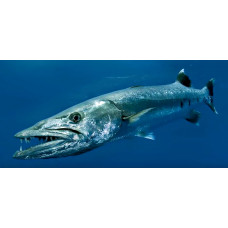Latin name
Sphyraena barracuda
Other names
Sphyraena barracuda
Identification
Characteristic of this fish is a large head with a massive lower jaw. Great Barracuda, one of the largest of the barracudas. These are elongated fish with powerful jaws. The lower jaw in a large mouth protrudes forward compared to the upper jaw. They have strong, fang-like teeth that are not uniform in size and are located in recesses in the jaws and on the palate. The head is rather large, pointed, and resembles that of a pike. The gill covers have no spines and are covered with fine scales. The barracuda has a large swim bladder.
Features of fish fins
The two dorsal fins are widely spaced: the first has five spines and the second has one spike and 9 soft rays. The second dorsal fin is equal in size to the anal fin and is more or less on top of it. The lateral line is well defined and runs straight from the head to the tail. The spinal dorsal fin is located above the pelvis. The posterior end of the caudal fin is forked or concave and is located at the end of the thick peduncle. The pectoral fins are low on the sides.
Fish colouring
The coloration is gray-blue from the top, turning silvery, and chalky white from the bottom. Sometimes there is a series of darker crossbars on the top and black spots on the underside. The second dorsal fin, as well as the anal and caudal fins, vary from dark purple to black with white tips.
Distribution
Indo-Pacific: Red Sea and east coast of Africa to Hawaii, Marquesas and Tuamotu Islands. Western Atlantic: Massachusetts (USA), Bermuda, and the entire Caribbean Sea to Brazil. Eastern Atlantic: Sierra Leone, Ivory Coast, Togo, Nigeria, Senegal, Mauritania, St. Paul's Rocks and São Tomé Island.
Habitat
A brackish water species. Depth range 0 to 100 m, usually 3 to 30 m. Juveniles are found in mangroves, estuaries and shallow sheltered areas of inner reefs; adults are found in a wide range of habitats from dark inner harbors to the open sea.
Size
Mature specimens typically reach 60-100 cm in length and weigh 2.5-9 kg. Occasionally, large specimens have reached 1.5 m in length and weighed up to 23 kg. Particularly large specimens have been recorded with record weights of 46.72 kg and 1.7 m in length, and 50 kg in weight and 2 m in length.
Behavior
Barracudas lead a more or less solitary life. Young and mature fish often gather in schools.
Food and feeding habits
Barracudas appear on the high seas. They are voracious predators that hunt by ambush. They rely on surprise and short bursts of speed up to 27 miles per hour (43 km/h) to outrun their prey, sacrificing maneuverability in the process. The diet of these top reef predators consists almost entirely of fish, cephalopods, and occasionally shrimp. Their fish diet consists of killifish, herring, sardines, gobies, silversides, anchovies, small mullets and lizardfish, to name a few. Large barracudas, once satiated, may attempt to gather a school of predatory fish in shallow water where they will guard them until they are ready to hunt again.
Reproduction
Can live up to 18 years. Spawning season is from April to October. Females can lay between 5,000 and 30,000 eggs.
Fishing
They are a popular target for recreational anglers because of their strong resistance to being hooked. They are also known for the pungent odor they emit when caught.
Relationship with a person
They feed on carrion and may mistake snorkelers for large predators and chase them, hoping to eat the remains of their prey. Barracudas have been reported to bite swimmers, but such cases are rare and may be due to poor visibility.
Fish flesh can cause ciguatera poisoning if eaten.
| Classification | |
| Phylum | Chordata |
| Class | Actinopterygii |
| Squad | Istiophoriformes |
| Family | Sphyraenidae |
| Genus | Sphyraena |
| Species | S. barracuda |
| Features | |
| Conservation status | Least Concern |
| Habitat | Pelagic |
| Life span, years | 18 |
| Maximum body weight, kg | 50 |
| Maximum length, cm | 200 |
| Sailing speed, m/s | 11,94 |
| Threat to people | Edible |
| Way of eating | Predator |
Great barracuda
Tags: great barracuda



